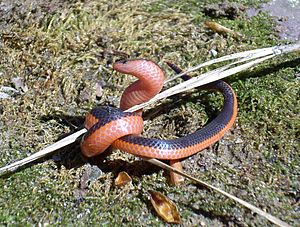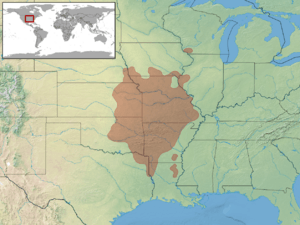Western worm snake facts for kids
- For the western worm snake from Namibia and South Africa, see Namibiana occidentalis
Quick facts for kids Western worm snake |
|
|---|---|
 |
|
| Carphophis vermis in Arkansas, USA | |
| Conservation status | |
| Scientific classification | |
| Genus: |
Carphophis
|
| Species: |
vermis
|
 |
|
| Synonyms | |
The Carphophis vermis is a small, harmless snake often called the western worm snake. It is a type of colubrid snake, which is a large family of snakes found all over the world. This snake lives in the United States.
Contents
What's in a Name?
The scientific name for this snake is Carphophis vermis. The word vermis comes from Latin. It means "worm." This name fits the snake well because it looks and acts a lot like a worm!
How to Spot a Western Worm Snake
Western worm snakes have a special look. Their backs are usually dark, like black or purplish. But their bellies are a bright, light pink or reddish color. This makes them easy to tell apart from other snakes.
These snakes are quite small. Adult western worm snakes are usually about 19 to 28 centimeters (7.5 to 11 inches) long. The longest one ever recorded was about 37.5 centimeters (14.8 inches) long.
Where Do Western Worm Snakes Live?
You can find western worm snakes in several states in the United States. They live in southern Iowa, southeastern Nebraska, eastern Kansas, and western Illinois. They also live in Missouri, Louisiana, eastern Oklahoma, and northeastern Texas. Sometimes, they are found in southwestern Wisconsin, southeastern Arkansas, and middle Tennessee.
Behavior of the Western Worm Snake
Western worm snakes spend most of their time underground. They are known as fossorial animals, meaning they are good at digging. You can find them buried in loose, rocky soil. They also hide under damp forest leaf litter.
These snakes are common where they live. However, you might not see them often. This is because they are very secretive and prefer to stay hidden.
Life Cycle and Reproduction
Not much is known about how western worm snakes mate. They likely breed in the early spring. The female snakes lay their eggs in the early summer. A group of eggs, called a clutch, usually has 1 to 8 eggs.
The baby snakes hatch in August or September. When they are born, hatchlings are about 3 to 4 inches (7.6 to 10 cm) long.
What Do Western Worm Snakes Eat?
The western worm snake's diet is mostly made up of earthworms. They love to eat these soft-bodied creatures. Sometimes, they will also eat other soft-bodied insects.
How Western Worm Snakes Defend Themselves
If a western worm snake feels bothered, it has a few ways to protect itself. It might release a bad-smelling musk from its body. This smell can be a warning to predators.
If someone picks up the snake, it might press its tail tip into their hand. This is another way it tries to get away and defend itself.


